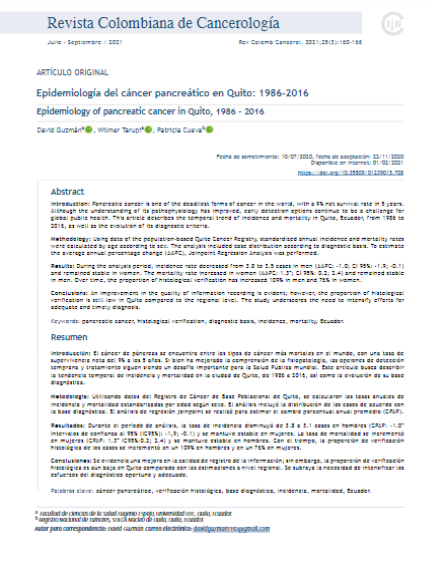Epidemiology of Pancreatic cancer in Quito: 1985 - 2015
DOI:
https://doi.org/10.35509/01239015.708Keywords:
pancreatic cancer, histological verification, diagnostic basis, incidence, mortality, EcuadorAbstract
Introduction: Pancreatic cancer is one of the deadliest cancers in the world, with a 9% net survival rate in 5 years. Although the pathophysiology understanding has improved, early detection options continue challenging the global Public Health. This article describes the temporally trend of incidence and mortality in Quito, Ecuador from 1985 to 2015, as well as the evolution of its diagnostic base.
Methodology: Using data of Population Based Cancer Registry of Quito, the standardized annual incidence and mortality rates were calculated by age according to sex. The analysis included the case distribution according to the diagnostic basis. To estimate the annual average percentage change (APC) Joinpoint regression analysis was performed.
Results: During the analysis period, the incidence rate decreased from 3.8 to 2.8 cases in men (CPAP: -1.1) and remained stable in women. The mortality rate was stable in both sexes. Over the time, the histological cases proportion verification has increased 109% in men and 76% in women.
Conclusions: An improvement in the quality of information recording is evident; however, the proportion of histological verification is still low at the regional level, underscoring the need to intensify prevention efforts.
References
Yin, F., Saad, M., Xie, H., Lin, J., Jackson, C. R., Ren, B., et al. (2020). Validation of American Joint Committee on Cancer 8th edition of TNM staging in resected distal pancreatic cancer. World Journal of Gastrointestinal Pharmacology and Therapeutics 2020; 11(2), 25.
De La Cruz, M. S. D., Young, A. P., & Ruffin, M. T. (2014). Diagnosis and management of pancreatic cancer. American family physician, 2014; 89(8), 626-632.
Siegel RL, Miller KD, Jemal A. Cancer statistics, 2018. CA Cancer J Clin. 2018;68(1):7–30. doi: 10.3322/caac.21442.
Goss, P. E., Lee, B. L., Badovinac-Crnjevic, T., Strasser-Weippl, K., Chavarri-Guerra, Y., St Louis, J., et al (2013). Planning cancer control in Latin America and the Caribbean. The Lancet Oncology 2013; 14(5), 391-436.
Forman, D., Bray, F., Brewster, D. H., Gombe Mbalawa, C., Kohler, B., Piñeros, M., ... & Ferlay, J. Cancer Incidence in Five Continents, Vol. X (electronic version) Lyon, IARC. http://ci5.iarc.fr (Accesed last time 28/10/2020)
Allemani C, Matsuda T, Di Carlo V, Harewood R, Matz M, et al. Global surveillance of trends in cancer survival 2000-14 (CONCORD-3): analysis of individual records for 37 513 025 patients diagnosed with one of 18 cancers from 322 population-based registries in 71 countries. Lancet. 2018; 391(10125):1023-1075. doi: 10.1016/S0140-6736(17)33326-3
Registro Nacional de Tumores (RNT). Cueva, P.; Yépez, J.; Tarupi, W. editores. 2019. Epidemiología del Cáncer en Quito 2011-2015. 2019; Quito. 16 ed.
Piñeros, M., Abriata, M. G., Mery, L., & Bray, F. (2018). Cancer registration for cancer control in Latin America: a status and progress report. Revista Panamericana de Salud Pública, 41, e2
Instituto Nacional de Estadistica y Censos (INEC) (1990). Quito-Ecuador. https://www.ecuadorencifras.gob.ec/
Instituto Nacional de Estadistica y Censos (INEC) (2001). Quito-Ecuador. https://www.ecuadorencifras.gob.ec/
Villacís B., Carrillo D. (2011). Estadística Demográfica en el Ecuador: Diagnóstico y Propuesta. Instituto Nacional de Estadística y Censos (INEC). Quito – Ecuador.https://www.ecuadorencifras.gob.ec/censo-de-poblacion-y-vivienda/
National Cancer Institute. Surveillance Research: Joinpoint Regression Program. 2015, https://surveillance.cancer.gov/joinpoint/22222
Corral F., Cueva P., Yepez J., Tarupi W. Trends in cancer incidence and mortality over three decades in Quito - Ecuador. Colomb Med (Cali). 2018; 49(1): 35-41. Doi: 10.25100/cm.v49i1
Bray F., Ferlay J., Soerjomataram I., Siegel R. L., Torre L. A., Jemal A. 2018. Global cancer statistics 2018: GLOBOCAN estimates of incidence and mortality worldwide for 36 cancers in 185 countries. A Cancer Journal for Clinicians 2018; 68(6):394–424. doi: 10.3322/caac.21492.
GBD 2017 Risk Factor Collaborators. (2018). Global, regional, and national comparative risk assessment of 84 behavioural, environmental and occupational, and metabolic risks or clusters of risks for 195 countries and territories, 1990–2017: a systematic analysis for the Global Burden of Disease Study 2017. Lancet, |392(10159), 1923.
Bray F, Colombet M, Mery L, et al, editors. Cancer Incidence in Five Continents, Vol. XI (electronic version). Lyon: International Agency for Research on Cancer. http://ci5.iarc.fr. (Accesed last time 27/10/2020)
Nilda Villacrés. 2016. Análisis del financiamiento de la atención del cáncer en el Ecuador: un reto para el Sistema Nacional de Salud. Rev Fac Cien Med (Quito) 2016; 41 (1):185-194
Ruales J, Checa F. 2018. La atención de cáncer en el Ecuador: pasado, presente y futuro. Rev. Fac. Cien Med (Quito) 2018;43 (1): 7-14
Bray F, Znaor A, Cueva P, Korir A, Swaminathan R, Ullrich A, Wang S, Parkin D. 2015. Planificación y desarrollo de registros de cáncer de base poblacional en los países de ingresos bajos y medios. IARC: Publicaciones técnicas 2015; No 43.
Molina A. 2019. Funcionamiento y Gobernanza del Sistema Nacional de Salud del Ecuador. 2019. Íconos. Revista de Ciencias Sociales, (63), 185-205.
How to Cite
Downloads

Downloads
Published
Issue
Section
License
Todos los derechos reservados.




